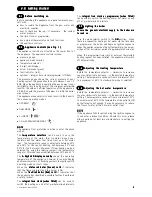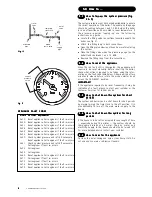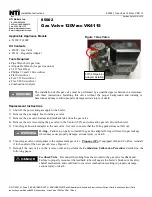
6
66
66
© Halstead Boilers Ltd 2008
C O D E
C O D E
C O D E
C O D E
C O D E ACTION REQUIRED
ACTION REQUIRED
ACTION REQUIRED
ACTION REQUIRED
ACTION REQUIRED
AL10
Reset appliance. Call engineer if fault re-occurs
AL20
Reset appliance. Call engineer if fault re-occurs
AL21
Reset appliance. Call engineer if fault re-occurs
AL26
Reset appliance. Call engineer if fault re-occurs
AL28
Reset appliance. Call engineer if fault re-occurs
AL34
Reset appliance. Call engineer if fault re-occurs
AL40
Check system pressure and refill if necessary.
Reset appliance. Call engineer if fault re-occurs
AL41
Check system pressure and refill if necessary.
Call engineer if fault re-occurs
AL52
Call engineer
AL55
Call engineer
AL60
Reset appliance. Call engineer if fault re-occurs
AL71
Call engineer if fault re-occurs
AL73
Call engineer if fault re-occurs
AL74
Reset appliance. Call engineer if fault re-occurs
AL79
Reset appliance. Call engineer if fault re-occurs
A
AA
A
APPPPPPLIANC
PLIANC
PLIANC
PLIANC
PLIANCE F
E F
E F
E F
E FA
AA
A
AUL
UL
UL
UL
ULT C
T C
T C
T C
T CODES
ODES
ODES
ODES
ODES
correct
pressure
value
flow/return
pipe
control
valve
temporary
connection
control
valve
supply
pipe
double
check valve
fig. 2
fig. 2
fig. 2
fig. 2
fig. 2
3.1
3.1
3.1
3.1
3.1
How to top-up the system pressure (fig.
How to top-up the system pressure (fig.
How to top-up the system pressure (fig.
How to top-up the system pressure (fig.
How to top-up the system pressure (fig.
2 & 3)
2 & 3)
2 & 3)
2 & 3)
2 & 3)
The system pressure must be checked periodically to ensure
the correct operation of the boiler. The needle on the gauge
should be reading between 1 and 1.5 BAR when the boiler
is in an off position and has cooled to room temperature. If
the pressure requires ‘topping-up’ use the following
instructions as a guide.
●
Locate the filling valve connections (usually beneath the
boiler, see fig. 2).
●
Attach the filling loop to both connections.
●
Open the filling valve slowly until you hear water entering
the system.
●
Close the filling valve when the pressure gauge (on the
boiler) reads between 1 and 1.5 BAR.
●
Remove the filling loop from the connections.
3.2
3.2
3.2
3.2
3.2
How to reset the appliance
How to reset the appliance
How to reset the appliance
How to reset the appliance
How to reset the appliance
When the red fault LED is illuminated, the appliance will
require to be reset manually. Before resetting the boiler,
check what action is required to be taken, using the infor-
mation on the fault code table below. Allow a period of two
minutes to elapse before rotate the mode selector knob
across the OFF/RESET position.
I M P O R
I M P O R
I M P O R
I M P O R
I M P O RTTTTTA N
A N
A N
A N
A N TTTTT
If the appliance requires to be reset frequently, it may be
indicative of a fault, please contact your installer or the
Customer Services for further advice.
3.3
3.3
3.3
3.3
3.3
How to shut down the system for short
How to shut down the system for short
How to shut down the system for short
How to shut down the system for short
How to shut down the system for short
periods
periods
periods
periods
periods
The system and boiler can be shut down for short periods
by simply turning the time clock to the off position. It is
also advisable to turn off the main water supply to the
house.
3.4
3.4
3.4
3.4
3.4
How to shut down the system for long
How to shut down the system for long
How to shut down the system for long
How to shut down the system for long
How to shut down the system for long
periods
periods
periods
periods
periods
If the house is to be left unoccupied for any length of time
– especially during the winter – the system should be
thoroughly drained of all water. The gas, water, and
electricity supply to the house should also be turned off.
For more detailed advice contact your installer.
3.5
3.5
3.5
3.5
3.5
How to care for the appliance
How to care for the appliance
How to care for the appliance
How to care for the appliance
How to care for the appliance
To clean the outer casing use only a clean damp cloth. Do
not use any scourers or abrasive cleaners.
3.0
3.0
3.0
3.0
3.0 How to ...
How to ...
How to ...
How to ...
How to ...
fig. 3
fig. 3
fig. 3
fig. 3
fig. 3


























